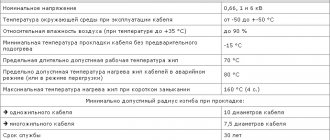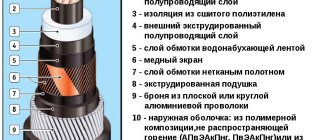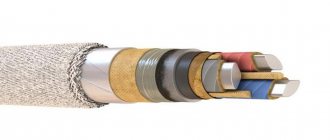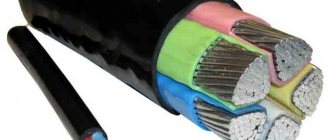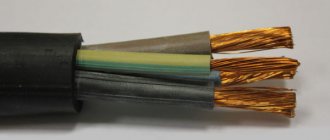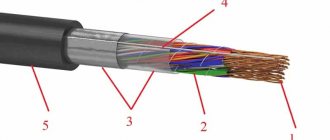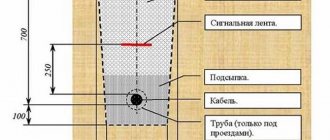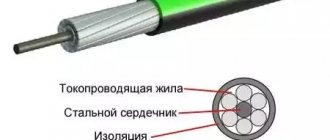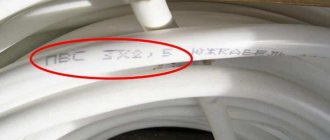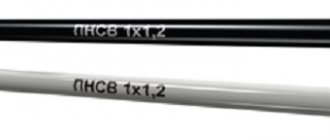The AVBbShv power cable is used as a transmission cable between various structures, for example from a transformer substation to a high-rise building. This is a high-voltage cable, so it cannot be used for wiring inside buildings or structures. Different types of cables, differing in number, cross-section and type of cores, are intended for use in alternating current networks with an industrial frequency of 50 Hz and voltages of 1.6 and 10 kV.
This wire can also be used to transmit higher voltage DC current. In this case, an increased current coefficient of 2.4 applies. That is, a cable of the AVBbShv type, structurally intended for use in industrial frequency AC networks at a voltage of 1000 V, can also be used in DC transmission networks at a higher voltage - up to 2400 V.
AVBBShv cable design
Let's look at the structure layer by layer.
- In the central part there is a conductor that conducts current. It is aluminum, soft, with a round cross-section (for cables rated at 6 kV, cores woven from three wires are typical).
- The cores are enclosed in insulating sheaths; For these purposes, non-flammable, reflective and fairly durable PVC plastic is used.
- Shielding layers (metal or plastic, with a winding made of paper electrical conductor) - only for products designed for a network voltage of 6 kV.
- Armor. Consists of galvanized steel strips twisted in a spiral.
- Filler-layer (it can be PET film, plastic compound or other material with similar properties.
- Protection in the form of a casing (PVC plastic, non-flammable, UV resistant).
What does the name mean?
Each letter of the AVBBShV cable marking has a meaning:
- A - aluminum conductors;
- B - the insulation of each core is made of polyvinyl chloride (PVC);
- B - the wire is armored;
- b - there is no protective layer between the cores in their own insulation and the outer sheath;
- Ш - external general insulation is a shell pressed in the form of a hose;
- c - external insulation material - polyvinyl chloride.
Thanks to the presence of several layers of shells made of different materials, the cable has reliable protection from any external influences. It can be laid open in an earthen trench, provided that it is not subject to tensile forces (that is, it is not tensioned). Armor made of two thin galvanized steel strips twisted in a spiral provides reliable protection against the teeth of rodents, accidental impacts with a shovel during excavation work, and the like. PVC hose insulation ensures reliable sealing; This product is not afraid of moisture, it can even be installed in underground sewers.
Please note: cable type AVBbShvng LS is also available. This marking indicates insulation that is particularly resistant to fire and high temperatures. This cable is used for laying in fire and explosion hazardous areas, where there is or may be high temperature, etc.
The minimum service life of this type of cable declared by manufacturers is 30 years. Well, you need to take into account that AVBbShv is a type of cable produced by many different companies. Different manufacturers produce it both according to GOST and their own specifications. Of course, only GOST products are recommended.
The cable marking must indicate the number and cross-section of cores. For example:
- 2×2.5 - 2 round cores of 2.5 mm each;
- 3×50 - 3 cores of 50 mm each;
- 3×6 + 1×2.5 - 3 cores with a cross-section of 6 mm and 1 additional one with a cross-section of 2.5 mm, and so on.
The minimum cross-section of the cores is 2.5 mm, the maximum is 150 mm or more.
Twin-core varieties of this cable always have a round cross-section of the cores. With three or more multi-core cables the situation is variable, but from a technical and operational point of view there is no difference between cables with different conductor shapes.
Technical characteristics of the cable AVBbShv
Unom - 0.66, 1, 3 and 6 kV. Rated frequency - 50 Hz. Operating mode, t - from -50 °C to +50 °C. Relative air humidity (at t0 +35 °C) – up to 98%; Service life: 30 years. Warranty: 5 years (from the date of start of operation). Carrying out installation work without preheating at temperatures from -15 °C and above.
Tmax permissible heating of cores for devices: - during operation: up to +70 °C; — in emergency condition: up to +80 °C. — with a short circuit: up to +160 °C.
Rmin of bending during installation: - for single-core devices ? 10 external?; — for multi-core devices ?7.5 external?;
Construction length - with a cross-section of 1.5-16 mm2 - 450 m. - with a cross-section of 25-70 mm2 - 300 m. - with a cross-section from 95 mm2 - 240 mm2 - 200 m.
More clearly in the table:
Installation work
The AVBbShv power cable can be installed both indoors and on walls, as well as in the thickness of the soil, in difficult areas (sewers, mines, subways, trenches, etc.), subject to the permissible bending radius and at a certain ambient temperature. Severe deformation of the product is contraindicated.
Scope of application
AVBbShv cable can be used for horizontal and inclined installation in metal and plastic boxes, directly in the ground (provided the deforming effects are insignificant), and also stretched in the air. It is used for open and closed wiring, including in the following situations:
- as a power line wire;
- in subways, sewers, tunnels and other similar places;
- inside civil or industrial buildings;
- by open casting over rivers, lakes, sea areas at an altitude of no more than 4300 meters above sea level;
- in partially flooded rooms and other environments with high corrosive activity.
It can also be used in fire hazardous areas, although for them it is recommended to use a specialized variety marked with the letter code LS. It is also permissible to use this cable in explosive areas of categories B-Ib, B-Ig, B-II, B-Ia. When laid alone, the product does not propagate a combustion reaction.
When laid open in soil, sand, clay or any other type of soil, the cable can withstand the highly corrosive activity of the soil. Insensitive to stray currents.
Estimated weight for cable AVBbShv
| Number of cores and nominal cross-section, mm2 | Weight of 1 km cable, kg | |
| 0.66 kV | 1 kV | |
| — 407 464 551 702 — 456 529 639 833 1002 1224 1491 1810 2133 2503 2934 3659 — 511 — | ||
| 2 ? 4 2 ? 6 2 ? 10 2 ? 16 2 ? 25 3 ? 4 3 ? 6 3 ? 10 3 ? 16 3 ? 25 3 ? 35 3 ? 50 3 ? 70 3 ? 95 3 ? 120 3 ? 150 3 ? 185 3 ? 240 4 ? 4 4 ? 6 4 ? 10 | 327 365 457 536 685 360 407 511 621 812 979 1199 — — — — — — 404 461 589 | |
Analogs
Among the analogues of the AVBbShv cable, among other wires of this class, we can name:
- ApvBbShv , characterized by a shell not made of PVC, but of cross-linked polyethylene;
- AVBbShvz , filled with unvulcanized rubber mixture;
- AVVBG , devoid of a protective shell.
But the scope of application of all these types of wire differs to some extent.
How to choose the right cable?
Before purchasing a cable for use at home, it is necessary to determine the required cross-section of the cores in accordance with the current power. In this case, you should also take into account the number and power of household electrical appliances and the total load on the network.
When choosing, you should take into account the fact that many manufacturers, to save money, reduce the cross-sectional area of the cores by 10% (which is allowed according to the specifications). Reducing the area reduces the technical characteristics of the wire, which can lead to an emergency situation, so products from trusted manufacturers should be preferred. You can check the cross-section using a special tool or by visual inspection of the casing.
Understanding the rules for deciphering the name abbreviation will also greatly help when selecting a cable. By marking you can determine the internal structure and types of materials used in manufacturing.
Tip #2: When purchasing, you should be extremely careful, as a large number of fakes have appeared recently.
AVBbShv 4x16 - reliable, high-quality and time-tested power cable
Outer diameters of cables for voltage 1 kV, mm
| Nominal cross-section of cores, mm2 | AVBbShv |
| 2x6 | 17 |
| 2x10 | 19 |
| 2x16 | 21 |
| 2x25 | 24 |
| 2x35 | 26 |
| 2x50 | 30 |
| 3x6 | 18 |
| 3x10 | 20 |
| 3x16 | 22 |
| 3x25 | 25 |
| 3x35 | 28 |
| 3x50 | 31 |
| 3x70 | 33 |
| 3x95 | 37 |
| 3x120 | 40 |
| 3x150 | 44 |
| 3x185 | 47 |
| 3x240 | 53 |
Outer diameters of cables for voltage 0.66 kV, mm
| Nominal core cross-section, mm2, nx S | AVBbShv |
| 2x4 | 15 |
| 2x6 | 16 |
| 2x10 | 19 |
| 2x16 | 20 |
| 2x25 | 24 |
| 2x35 | 26 |
| 2x50 | 29 |
| 3x6 | 16 |
| 3x10 | 17 |
| 3x16 | 19 |
| 3x25 | 21 |
| 3x35 | 25 |
| 3x50 | 31 |
How to avoid becoming a victim of counterfeiting?
So, the last point on which I would like to dwell in more detail is the choice of a high-quality manufacturer of armored cable type AVBbShv. Today, there are many companies engaged in the production of electrical products, including current conductors. The problem is that a considerable part of them skimp on material, which affects such indicators as the actual size of the cores and the quality of the materials.
For example, if according to calculations you need a cable with a minimum cross-section of 16 mm2, then it is not a fact that you will buy a product with exactly this value. In most cases, the core diameter is 10-15% smaller, which negatively affects the permissible current loads. As a result, after electrical installation, wiring failure, short circuit and, as a result, labor-intensive repair work may occur.
To prevent this from happening, we recommend giving preference to high-quality cable manufacturers AVBbShv, which are recommended on many forums and which, in turn, have a lot of positive reviews.
Among such manufacturers it is worth highlighting:
- Kolchuginsky plant
- Amur Cable Plant
- Energy cable
- Sevkabel
- Pskovkabel
In addition, we recommend that you check the product yourself before purchasing, using one of the methods for determining the diameter of the cores. If the values correspond and the appearance of the cable is not in doubt, you can safely buy it.
That's all I wanted to tell you about the conditions of use, manufacturers and technical characteristics of the AVBbShv cable. We hope that the information was interesting and useful for you. If you have any questions, ask our specialists in the “Ask an Electrician” category!
terms of Use
The technical characteristics of the AVBbShv cable are designed for its above-ground and underground operation. Thanks to the presence of armor, the wire is able to withstand pressure from the ground. But this is only true if the latter has low corrosive activity. Also during the installation process, it is worth considering that the cable is susceptible to tensile forces.
The wire is no less actively used in tunnels, mines and other premises. The cable can be used in open areas. The laying line must be stationary with a vertical, inclined or horizontal arrangement. The humidity level should not exceed 90%, and operating temperature indicators are indicated in the technical specifications of the cable.
Overview of the main manufacturers
| Cable brand | Manufacturer | Characteristics | Estimated cost, rub./m |
| AVBBShv 4x150-1 | Kolchuginsky, RF | Number of cores: 4 Section: 150 mm2 | 410 |
| AVBbShv 2x 16 | Beltelekabel, RB | Number of cores: 2 Section: 16 mm2 | 310 |
| AVBBShv 4x240-1 | Pskovkabel | Number of cores: 4 Section: 240 mm2 | 630 |
| AVBbShv 4x50-0.66 | Sevkabel, RF | Number of cores: 4 Section: 50 mm2 | 200 |
Before purchasing a cable, you must carefully determine the load from all powerful electrical appliances in the house.
How to decipher the AVBbShv markings
There are hundreds of brands of cables. In order not to get confused, each of them is assigned its own letter marking. It is applied to the outer insulation of the cable and is located along its entire length. Additionally, markings can be found on the bay in which it is supplied. It contains basic information about the material of the product, its purpose and operating conditions.
In the name of the cable AVBBSHV, the decoding of the letters carries the following information:
- A - indicates that the conductors are made of aluminum;
- B – polyvinyl chloride based insulation is used;
- B – the cable is equipped with armor made of galvanized steel tape;
- b – the protective layer between the conductors and the armor is excluded;
- Shv – outer sheath based on PVC hose.
Next comes the typical designation for all cables for the number of current-carrying cores and their cross-section. For example, 3x25 + 1x16 means that 3 main (phase) wires have a cross-section of 25 square meters. mm each. And one grounding or zero - 16 square meters. mm.
Additionally, information about climatic operating conditions may be indicated. The abbreviation “HL” means cold-resistant, and “T” means tropical.
Note! If in the future it is planned to increase the power of the consumer, which is powered through the cable, then it is better to take its cross-section with a reserve, i.e. buy a conductor with a larger diameter.
FAQ
Question No. 1. Is it possible to lay an underground line using an AVBbShv power cable on a peat bog?
It is possible, only the cable needs to be laid in a plastic pipe to prevent contact with an aggressive environment.
Question No. 2. When laying an inclined route, is it allowed to use AVBbShv cable?
Power cable brand AVBBShV can be laid in cable trunks running both horizontally and at an incline.
Question No. 3. Is there any protection for the cable from mold, since its scope of application extends to places with high humidity?
There is no protection as such. For such operating conditions, it is necessary to use a cable marked with the letter “T”.
Question No. 4. Is it possible to use AVBBShv for laying home electrical wiring?
Despite the fact that the use of aluminum wire is not welcomed by electricians for wiring a home network, due to its low cost, the cable is often used in home electrical wiring.
Question No. 5. Is laying cables in overhead lines allowed?
Yes. If there is a risk of cable damage under underground installation conditions, an overhead line may be installed.
Product selection criteria
The choice of a quality product is quite important, since there are a great many manufacturers of this type of product and one can get confused in this matter very easily. Many companies prioritize cost savings rather than quality. This may be reflected in the difference between the actual cross-section of the cores and the nominal size or in the quality of the materials themselves.
The cross-sections of the wires do not always correspond to the parameters specified in the passport data; they can be 10-15% smaller. The fact is that it is difficult for a person ignorant in this matter to determine the actual size of the veins with the naked eye. The result may be wiring failure, overload and short circuit during operation.
It is recommended to exercise caution when purchasing, pay attention to the manufacturer and whether it has positive customer reviews in order to avoid counterfeiting. Carefully inspect the appearance of the product and take the necessary measurements, use methods for determining the diameter of the wires
The competitive price and lower weight of the AVBbShv brand, compared to analogues made from copper conductors, determine their great demand and popularity. Such a disadvantage of aluminum as oxidation is eliminated by using a special coupling at the joints. The presence of protective armor on these cables ensures resistance to mechanical stress.
Standards for installation in the ground
In practice, when installing a cable line in the ground, consisting of the brand of cables in question, it is required to comply with the rules of the Electrical Regulations. This includes:
- Laying should be carried out on a site without buildings at a depth of 0.7 m, in buildings at a depth of 1 m.
- The cables should be spaced 10 cm apart from each other.
- During installation, avoid torsion of the product.
- Installation should be carried out without tension along the entire length.
- Before carrying out installation work, you need to make a cushion of sand along the bottom of the trench 10 cm thick.
- After installation, it is necessary to cover the cable line with a layer of sand 10 cm thick.
- Place warning tape at a distance of 25 cm from the cables.
- Backfilling should be done with crushed soil with dense compaction of each layer to prevent subsidence.
You also need to know the installation distances from other utility networks and communications. According to the standards they are as follows:
- 2 m from the heating main.
- 1 m from the water main.
- When crossing a highway or railway track, installation is carried out in a protective pipe.
- installation in a pipe should be done when crossing other cable lines.
In practice, three methods of laying cables in the ground are used:
- Mechanized, when a trench is dug with an excavator and installation is done manually.
- Without preliminary digging of a trench, when the installation is carried out by a special cable layer. He immediately digs and places the product in the ground.
- Manual, when it is not possible to use mechanisms or there is a threat of interfering with other utility networks.
Features of laying, cutting and connecting cables
The trench for the cable must be at least 0.7 m deep and at least 0.5 m wide.
The structure of the cable with an armored sheath presupposes its laying in conditions where powerful mechanical impacts on it are possible, which it successfully withstands. Therefore, it is not recommended to lay an expensive cable with armor where it can be done with another less expensive one. AVBbShv is often laid underground, from power transmission towers or transformer substations to the switchgear of objects to which power is supplied.
Taking into account the weight and rigidity of the cable, laying is carried out from a drum, which is installed above the trench on special trestles. The cable is sequentially unwound and placed on the bottom of the trench, sprinkled and compacted with a 7-10 cm layer of sand.
Afterwards, everything is covered with sand to a depth of 5-7 cm, laid with a layer of brick, and warning tape is placed on top. The brick and tape provide a protective layer in case of excavation work to prevent damage to the cable.
At the ends of the cable at the connection points, the cable is cut, the layer of insulation and armored tape is removed. To prevent moisture from entering by sucking condensate under the insulating layer or by direct flow of water, in networks up to 10 kV, the ends are sealed in different ways:
- Steel funnel;
- Rubber glove;
- PVC funnel with epoxy resins;
- Polyvinyl chloride tapes and heat-shrinkable tubes;
Removal of the insulating and armored layer is carried out at a certain distance from the ends, depending on the device used to seal the ends of the cable.
- G – bare ends of cores;
- F – insulating layer of the current-carrying core;
- P – layer of belt insulation;
- O – intermediate insulation shell;
- 4 – armored cable tapes;
- A – cutting distance from the ends of the cable to the armored tape
Dimensions for cutting with epoxy funnels KVEp and KVEZ
| Types of epoxy resin funnels | Cutting dimensions, cm | ||||
| A | ABOUT | P | G | B | |
| KVEp-1, KVEp-2 | 17 | 3,5 | 2 | 4,0 | — |
| KVEp-3, KVEp-4 | 21 | 5,0 | 2 | 4,5 | — |
| KVEp-5, KVEp-6 | 24 | 5,0 | 2 | 5,0 | — |
| KVEp-7 | 24,5 | 5,0 | 2 | 3,5 | — |
| KVEZ-1 | W+5.5 | 3,5 | 2 | — | 9,0 |
| KVEZ-2, KVEZ-3 | W+5.5 | 3,5 | 2 | 2,5 | 9,5 |
| KVEZ-4, KVEZ-5 | W+5.5 | 3,5 | 2 | 2,5 | 12 |
The sizes of the funnels are selected according to the size of the cable; for rubber gloves and PVC tapes, the cutting of insulation has different dimensions
An example of installing a cable with a rubber glove at the end in a switchgear or control panel
Dimensions for cutting cables for KVV PVC tape:
| Sealing type | Cable cross-section in mm2, voltage, kV | Cutting length in cm | ||||
| 1 | 6 | 10 | A | ABOUT | P | |
| KVV-1 | Up to 24 | — | — | W+6.5 | 3,0 | 1,5 |
| KVV-2 | 36…50 | 10…24 | — | W+7.0 | 5,0 | 2,0 |
| KVV-3 | 70…94 | 35…51 | 16…24 | F+10.5 | 8,0 | 2,5 |
| KVV-4 | 120… 151 | 70…94 | 35… 71 | F+10.5 | 8,0 | 2,5 |
| KVV-5 | 184 | 120…151 | 95…121 | F+12.5 | 10,0 | 2,5 |
| KVV-6 | 241 | 184 | 151 | F+12.5 | 10,0 | 2,5 |
| KVV-7 | — | 241 | 184 | F+12.5 | 10,0 | 2,5 |
| KVV-8 | — | — | 241 | F+12.5 | 10,0 | 2,5 |
Aluminum lugs along the cross-section of the conductor are attached to the ends of the current-carrying conductors using a crimping method, then they are screwed to the busbars on switchgears. A wire with a tip must be soldered to the armored tape, which is attached to the ground loop on both sides of the cable.
Advantages and disadvantages of AVBbShv
The main advantages of the cable include:
- Strength, resistance to mechanical stress;
- Versatility in laying methods;
- Wide range of cross-sections;
- Long-term service life.
The disadvantage can be considered the large weight, in the presence of an armored layer, which creates some inconvenience when laying, especially by air, and the high price compared to other brands without armor.
Approximate prices for 1m of cable in Russia:
| AVBbShv 5x2.5 | from 38.37 rub. |
| 5x4 | from 50.59 rub. |
| 5x6 | from 56.51 rub. |
| 5x10 | from 79.88 rub. |
| 5x16 | from 106.10 rub. |
| 5x25 | from 151.27 rub. |
| 5x35 | from 195.47 rub. |
| 5x50 | from 248.65 rub. |
| 5x70 | from 372.53 rub. |
| 5x95 | from 483.13 rub. |
| 5x120 | from 573.88 rub. |
| 5x150 | from 700.09 rub. |
| 5x185 | from 830.01 rub. |
| 5x240 | from 1058.46 rub. |

